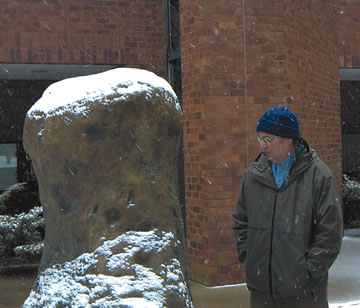On Friday, March 14, the Harbor Art Gallery was pleased to receive celebrated sculptor Bill Tucker for a discussion and slide show of his works over the last thirty years. Tucker, a respected artist in the U.S., Britain, and much of Latin America, was gracious enough to speak with interested faculty and students at the Harbor Art Gallery for an hour, before answering questions from those in attendance.
Tucker, who has four pieces displayed around the UMB campus, specializes in constructing large sculptures out of various materials that can reach a height of nearly fifteen feet and ten feet in width. Some of the materials he has used in the past include concrete, plywood, steel, chicken wire, and bronze. His sculptures have been placed in public parks, oceanfronts, and university campuses. His sculptures have appeared in Santa Barbara, California, Miami, Britain, and in a memorial park in Buenos Aires, Argentina, which was used as a dedication to the missing persons abducted and murdered during Argentina’s dictatorship of the late seventies and early eighties.
Born in England and educated at Oxford, Tucker began his work nearly thirty years ago. In his early days, he dedicated most of his work to the abstract. He used visual illusions with tubes, as well as laminated Masonite. These sculptures were not nearly as colossal as the ones he’d make later in life, though some were life size. The work he did during this time was idea-based and conceptual, which is found less and less in his later era.
He worked in London for twenty years before moving to the U.S. in the late 1970’s, making New York City his home. His New York apartment was limited in size, so he began making life-size drawings of shapes he’d later sculpt. He found the drawings helped him plan out his sculptures more effectively and gave him better perspective, because it allowed him to see his sculptures from different angles. To help finance his work, Tucker began teaching art.
Much of Tucker’s work during this era consisted of oddly distorted shapes and images. If one were to look hard enough at one of these sculptures then one might be able to make out a shape of something familiar, kind of like a Rorschach blot test, but Tucker never had any familiar images in mind when he constructed them. During his later years, he began making a series of sculptures that he dubbed “the horse head sculptures,” because of their likeness to a horse head. Tucker wasn’t trying to sculpt an exact horse’s head inch for inch; it was distorted with various bumps and oddities to disguise it enough to make the onlooker ponder for a moment about what it might be. Some require more pondering than others. Next, he began to design sculptures of human heads, with his trademark distortion.
One thing that Tucker prides himself on is that he constructs his sculptures himself, meaning he doesn’t simply draw them to paper and have a foundry engineer them for him. He believes that much of the creative process behind sculpting is lost when a sculptor takes his or her work to a foundry. This is one reason why his work is so respected in many areas of the world. When one sees the enormity and complex shapes of his sculptures, especially the ones of his later era, one begins to realize just how difficult a one-man construction process it must be.
Sometimes Tucker doesn’t even recognize his own work, he says. This may seem hard to believe, but when you’ve dedicated your life to sculpting and done so successfully for thirty years, it seems understandable. When he looks at his early work and compares it to his later work, he sees a different artist. The odd imagery he creates is alive in both eras, however, and at least gets the viewer to think about what they are seeing, even if the images can sometimes be simplistic.
Because he has had his hands on the creative process of his works from their beginnings in his mind, these works truly are his own. Since Tucker has no intention of slowing his pace down any time soon, one can expect to see several more pieces of work by him before he decides he’s said everything he has to say.
Special thanks need to be given to Paul Tucker, director of Arts on the Point, who is responsible for bringing Bill Tucker and his work to UMB.





















































